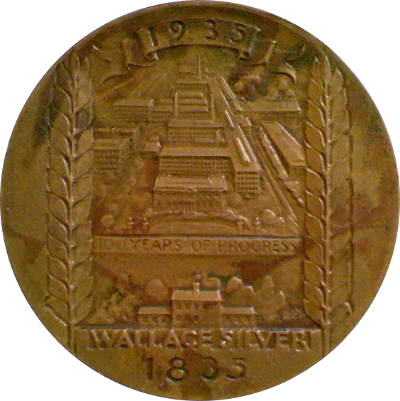Artist Name
You can click on the medals to see the reverse.


The obverse bears three figures representing poets, painters, and sculptors, ech holding tools of their trade; behind them rearing Pegasus. Around, ALLIED - ARTISTS - OF - AMERICA; around bottom, above exergue, signed and dated with U · ELLERHUSEN - 1930
The reverse bears naked, kneeling muse, facing left, holding painter's palette in right hand and small figurine in outstretched left. To left, MUTUM / EST / PICTURA / POEMA; signed and dated under palette, GEO LOBER / 1930
The Allied Artists of America was founded in New York City in the year 1914. The twelve original founders were Ernest Albert, Paul Cornoyer, Marshal Fry, Edmund Greacen, Arthur Powell, Walter C. Hartson, William R. Leigh, Frederick Mulhaupt, G. Glenn Newell, H. Ledyard Towle, H. A. Vincent and Jules Turcas.
This medal is a collaborative effort of two great medallic artists: Ulric Ellerhusen designed the obverse and Georg Lober the reverse. The motto on the reverse translates roughly to:
"A picture is a silent poem."
The circular medal was struck by the Medallic Art Company of New York. No mintage is reported.


The obverse bears founder's bust left. Above, ROBERT WALLACE; below to left and right, 1815 - 1892; signed (GL monogram) in right field.
The reverse shows factory in upper center with single family house below. Above, 1935; across center, 100 YEARS OF PROGRESS; in exergue, WALLACE SILVER / 1835
The medal is edge-marked ROBBINS CO / ATTLEBORO - GENUINE / BRONZE.
The founder of Wallace Silversmiths, Robert Wallace was born in Prospect, Connecticut on November 13, 1815. He learned the silversmith trade and started a small business whose only product was spoons. One day, while shopping in New York City, Wallace happened upon a piece of cutlery made of a nickel alloy called German silver that had been produced by Dixon and Sons of Sheffield, England. Impressed by the quality and strength of the piece, Wallace bought the formula from the German chemist Dr. Louis Feuchtwanger who had a small bar of that metal from Germany for the then unheard sum of $20 and went on to build these new nickel silver spoons. Later he found a man who had brought the recipe for making the metal. Wallace purchased that too. In his factory, he then compounded the first German silver made in America and pioneered the new industry.
Wallace moved his company from Cheshire to Wallingford and increased production. Over the decades, the business grew tremendously and by 1935 it was mass-producing cutlery at an astonishing speed.
The medal measures 73mm (2 7/8in) and was struck in bronze by the Robbins Company of Attleboro, Massachusetts.






This medal was chosen as the 52nd issue of the prestigious Society of Medalists series in 1955. The obverse bears head of Danish writer ad story teller facing left. Around, HANS . CHRISTIAN . ANDERSEN; below, 1805 (flower) 1955; below truncation; GEORG LOBER / ©.
The reverse bears swan swimming right. Around, ONE . HUNDRED . AND . FIFTIETH . ANNIVERSARY; below water, G L / (flower) / ©.
This is the first SOM medal that stepped away from philosophical or abstract themes to commemorate specific events or individuals. George Dupont Pratt, one of the SOM founders, had tried to set the Society apart from common practices by discouraging commemorative designs but Lober picked a figure that was different from the usual honorees. As one commenter wrote:
"While I am not partial to commemorative medals, I like this one... It is a pleasant change to have a medal commemorating the simple things in life rather than heroism, statesmanship or political achievement."
This medal was struck by the Medallic Art Company of New York. The reported production quantity of this medal is 681 in bronze.
Contact me if you have links that might merit inclusion on this page.
Books & Articles
Research Archives and Websites
Museums